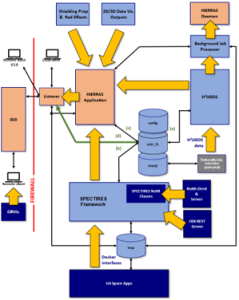Radiation Hazards and Scenarios System for Human Spaceflight

Develop a tool for radiation environment specification and warnings for human spaceflight. Specifications must consider high shielding, range of shielding materials and human dose quantities. Warnings must consider realistic monitoring infrastructure and a range of event scenarios.
A precursor GSP study (IPRAM) was performed to investigate systems for providing radiation environment specification and warnings for human spaceflight. Three specific scenarios described missions and simplified vehicles and habitats combined with radiation environment and propagation analysis to provide three databases of fluxes and dose quantities for pre-defined mission parameters.This activity re-uses components of the existing SEPEM system for evaluation of solar energetic particle environments but with significant extension in particle energy and shielding geometries specific to human exploration. Outputs of the 'Radiation shielding by ISRU and/or innovative composites for EVA vehicles and habitats' activities are considered in order to provide more detail on how the radiation environment is attenuated by vehicle, habitat, suit or body material, and the resulting radiation effects, in particular radiological end-points.This activity cover the development of a system for mission design which can deliver outputs based on adjusting parameters of foreseen scenarios. The activity encompasses:- Development of a radiation environment specification system for human exploration beyond LEO;- Consideration of realistic spacecraft/habitat geometries and materials;- Inclusions of planetary atmospheres where appropriate;- Outputs of attenuated and secondary radiation environments to be interfaced with tools to derive effects quantities;- Determinations of human stochastic (cancer-causing) and tissue reaction (deterministic) dose quantities;- Specification of warning times and hazard level for flux enhancements seen over a mission.The activity considers a realistic monitoring architecture to drive warnings in a space mission and defines required developments in terms of the monitoring architecture.
